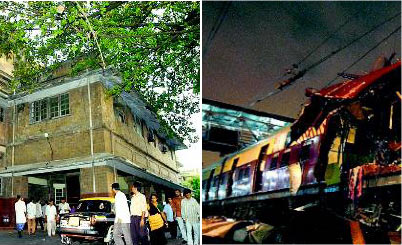British medical journal raves about what KEM did after terror
Times of India - Sunday 18th March 2007 Page 2
Mumbai: Aamchi Mumbai's public outpouring of support during disasters is well-known. But now a widely-respected British medical journal has acknowledged a city hospital's work after the serial blasts on local trains last July.
The February issue of the Lancet has carried a table comparing the response of KEM Hospital teams to the Mumbai blasts and the reaction of the Royal London Hospital to the tube blasts of 2005. The chart (see box) shows the Brihanmumbai Municipal Corporation-run KEM Hospital has performed on par with international disaster management norms.
Despite the no-nonsense medical feel, the Lancet review written by KEM Hospital dean Nilima Kshirsagar and others brings out the public reflex by detailing the short time taken in transporting victims to the hospital as well as the overwhelming blood donation. An impressive 1,165 people donated blood at the hospital. Although only in a letter format, the Lancet mention has enthused the hospital staff. "The contribution was peer-reviewed before being published, making it an acknowledgement of our work," Kshirsagar, who along with Sanjay Mehta and Aparna Deshpande wrote the letter, said.
Gustad Davar, who was the dean of the government-run J J Hospital when bombs ripped through the Gateway of India in August 2003, pointed out that public hospitals - with their large infrastructure, highly trained manpower and huge number of beds - always rose to the occasion during disasters.
"I have managed all the three bomb blasts in Mumbai (in 1993, 2003 and 2007) and, during each of these catastrophes, all the medical staff as well as volunteers would converge at the hospitals, be it J J or KEM or any other hospital to help out," Davar said.
The Lancet article says KEM Hospital managed to not only complete 16 of the 18 surgical procedures within 18 hours of the event but the time between the blast and the first patient reaching the hospital was an impressive 30 minutes. The first priority patient, in contrast, reached Royal London Hospital 75 minutes after underground blasts in July 2005. But this, as the article suggested, could also be because of the fact that the London network was underground.
Kshirsagar attributes KEM's winning statistics to the new disastermanagement plan.
"We had reviewed and reworked our plan in May 2006 in keeping with the points we picked up during the 26 July 2005 floods," she said.
"We were successful is responding to the blasts quickly because of the constant meetings to discuss the new DMP," she added.
Davar, who is now with a trust-run Hinduja Hospital, adds that Mumbai's USP at such times is the collective goodwill. "We turned away people who queued up at J J to donate blood after the 2003 blasts. The 2006 blasts also resulted in a similar response at Hinduja and our entrance and lobby had to be turned into an emergency medical room to treat victims pouring in from the blast sites."

Courtesy: "British Medical Journal raves about what KEM did after terror"
Date: 18 Mar 2007 - Times Of India Mumbai, Section: Times City, Page Number 2
http://epaper.timesofindia.com/Daily/Skins/EVAL/navigator.asp
